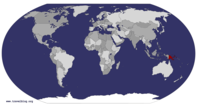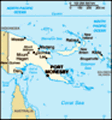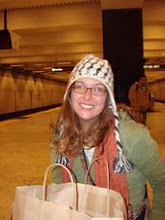I can hardly believe another week has come and gone. Things were busy for me this week. My move into Ed’s apartment with my two bags and a box of kitchen wares was by far the simplest move of my life. I took pleasure in turning the modestly furnished apartment my home. I filled the bare cabinets and draped the stained furniture with the hand-me-downs I have acquired from volunteers who have left since my arrival.

 My favorite spot is on my veranda where I have hung my hammock over looking the coconut, buai, guava, banana, and bread fruit trees.
My favorite spot is on my veranda where I have hung my hammock over looking the coconut, buai, guava, banana, and bread fruit trees.  My apartment complex. My veranda is 3rd from the left, top floor.
My apartment complex. My veranda is 3rd from the left, top floor.I am slowly piecing together a vision of my placement. The Madang Teacher’s College may benefit from an updated special education curriculum. The Creative Self Help Centre lacks a mission statement and vision with clear aims and goals. There is an identified need for direct lines of communication between the National level and Provincial levels of education particularly relating to Special Education. There are many opportunities and possible directions for my placement. In relation to sustainable development, I know my work would yield more benefits if I help to build the capacity of each stakeholder. However, my role is to train and assist teachers in inclusive practices, not to build the capacity of organizations. I am trying to find a balance where I am able to share the most of my skills while I am here. After school visits and interviews with key partners, I believe I have an idea of a starting point.
I went to MTC Wednesday to observe a lecture on Learning Disabilities. I read the course curriculum prior to my visit and I had many concerns with the outdated information. I contributed as much as time allowed during the lecture. I must have made an impression as I was invited to return Friday to give a lecture to two classes. I had one day to research and prepare for a two hour lecture on learning disabilities for over 30 teachers. Based on my review of the curriculum and my observation, I decided to focus on the characteristics and teaching strategies for each of the 8 areas of learning disabilities. The lecture was well received and I felt exhilarated. It felt incredible to be able to use and share my knowledge. I felt alive and passionate and for the first time I actually missed working as a school psychologist. I made resource packets full of teaching aids for each the 8 areas of LD. The two hours felt like 10 minutes. I could have continued to share for hours. Many teachers stayed behind to ask questions and get a closer look at the packets. I was invited to return next week to lecture for 3 more classes.
I was able to observe a screening at the Creative Self Help Centre with the Deaf Education Resource Unit. I have grown close with their team. They have relatively high levels of skills as they were trained by Callan National Unit, the largest disability NGO in PNG. The little boy was referred by his uncle, who happens to be a Special Education lecturer at MTC. I was surprised by the low level of awareness from the uncle and father, who is a teacher at a primary school. The 12 year old boy (who I guessed to be around 8 years old) had a severe ear infection that had traveled to his eyes. The boy passed his vision and hearing screenings and was given a prescription for antibiotics from the DERU nurse after the father was instructed on the importance of ear toileting (cleaning the ears) and avoiding swimming in stagnant water.
Each Saturday I look forward to my trips to the market. The crowds of people carrying bilums filled with fruits and vegetables. The passionate man shouting from the speaker’s corner—I think he is preaching the word from the Christian God.
 The hustle and bustle of men, women, and children pouring in and out of shops. The smell of the coconut oil factory. The respite of cool air inside Papindo’s supermarket. The squeals of the flying foxes. The occasional shouts of disagreement that send you in the opposite direction in fear of a bush knife being drawn. The largest carrots, zucchini, and squash I have ever seen. The widest variety of bananas from all across PNG.
The hustle and bustle of men, women, and children pouring in and out of shops. The smell of the coconut oil factory. The respite of cool air inside Papindo’s supermarket. The squeals of the flying foxes. The occasional shouts of disagreement that send you in the opposite direction in fear of a bush knife being drawn. The largest carrots, zucchini, and squash I have ever seen. The widest variety of bananas from all across PNG.  The sweat dripping down the small of my back. The weight of my growing bag ripping at my shoulder. It’s all a part of the market experience.
The sweat dripping down the small of my back. The weight of my growing bag ripping at my shoulder. It’s all a part of the market experience. Since eating and drinking seems to be all I do here lately, mi got bigpela bel. I have decided that I need to start exercising more regularly. I started tennis lessons last week at the Madang Country Club. An Australian Missionary and prior tennis instructor gives lessons for 5 kina every Wednesday. It’s a mixed group of Nationals, VSO vols and a teenage Indian boy. I need more than my once a week tennis lesson and the occasional Pilates DVD, so today I explored the kina beach area looking for a safe route for daily runs. I walked toward the sea where children were swimming and men and women were laying in the grass chewing betel nut. As I ran the loop around kina beach I stopped and introduced myself to families sitting on their verandas and people behind their buai stands. Just as I was feeling safe I ran upon an aggressive dog that began to bark and run towards me. His teeth looked sharp and his growl sounded fierce. I screamed and wished I had more than my empty hands to protect myself. I knew I couldn’t show fear and running was not an option, so I just stood still and quiet hoping he wouldn’t attack. Luckily this tactic worked and he simply walked away. Hopefully I will not run into him tomorrow.
























